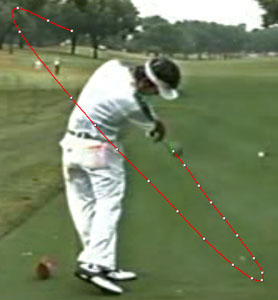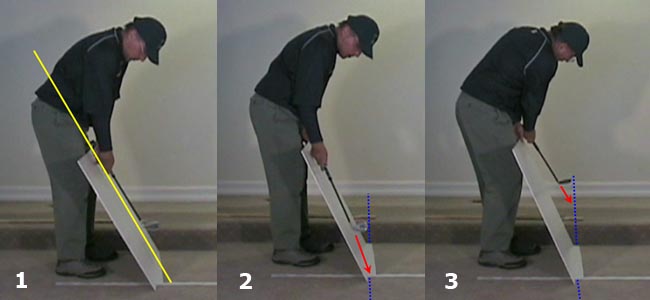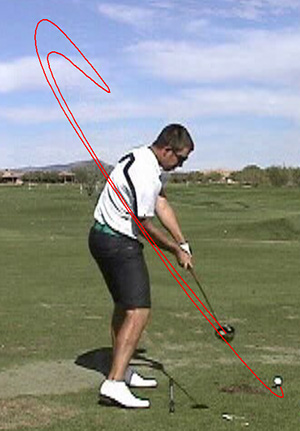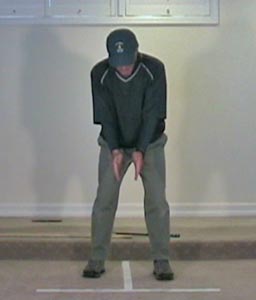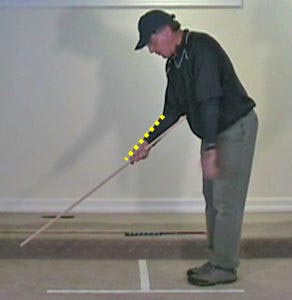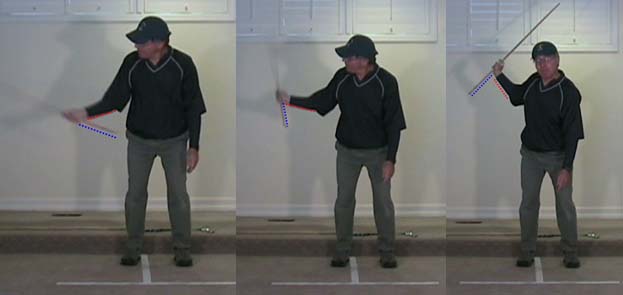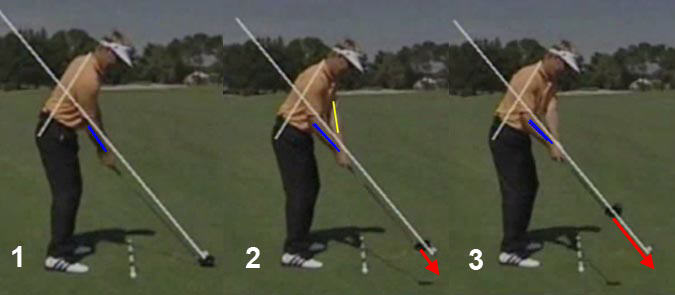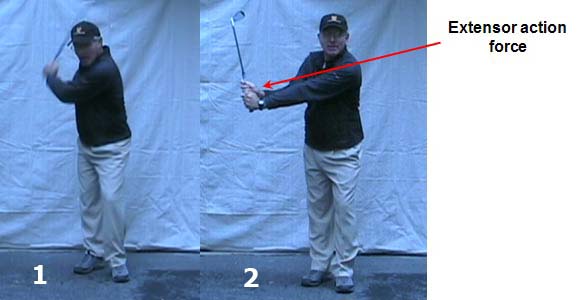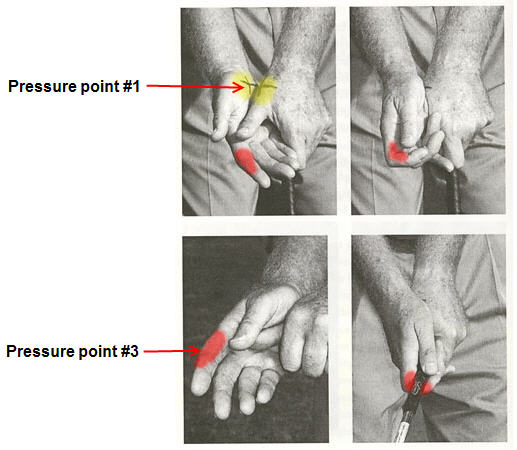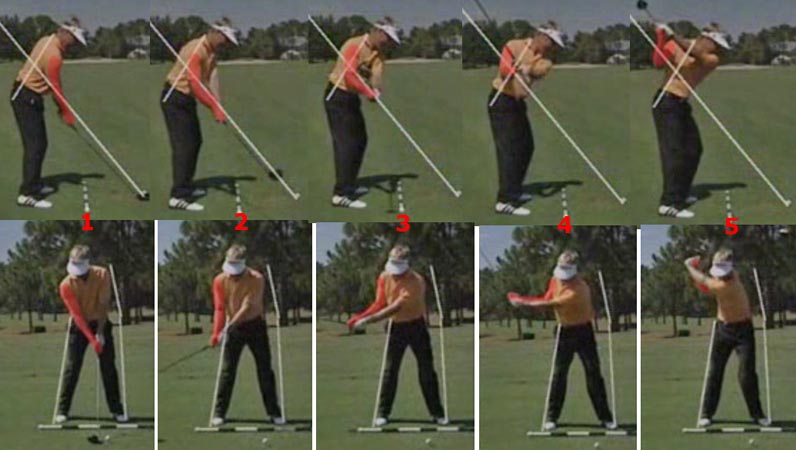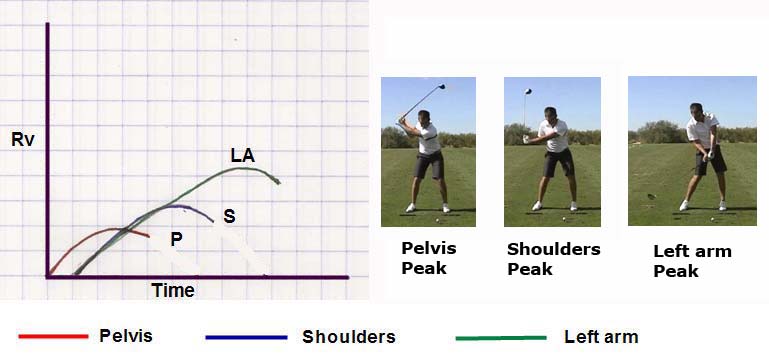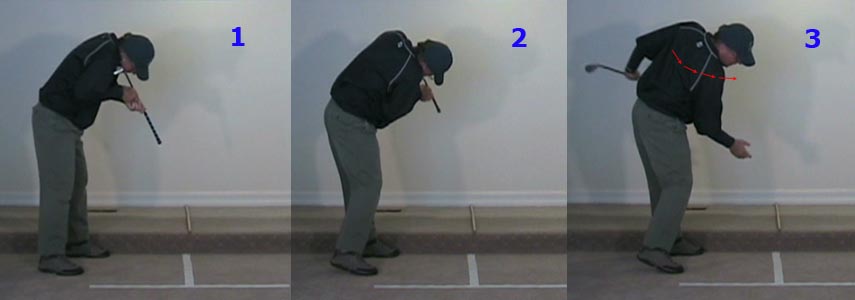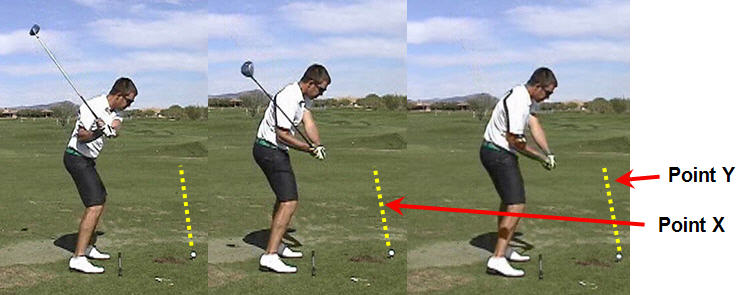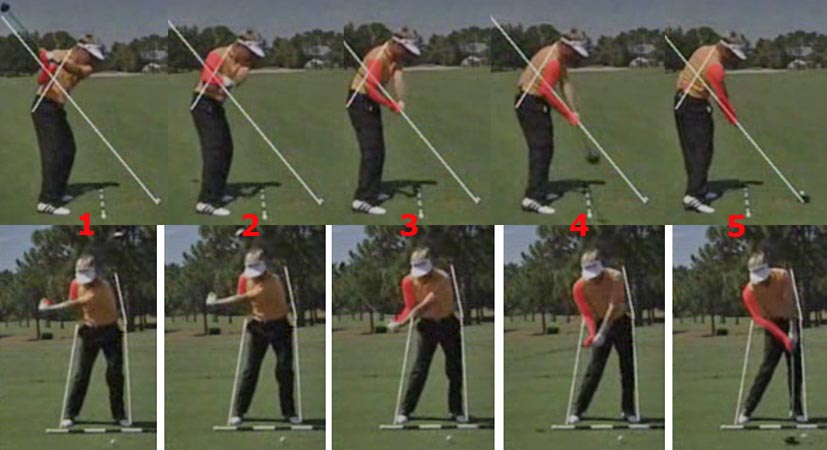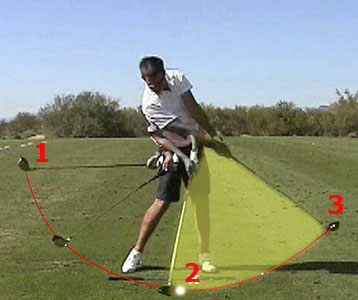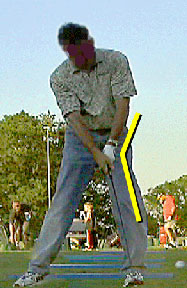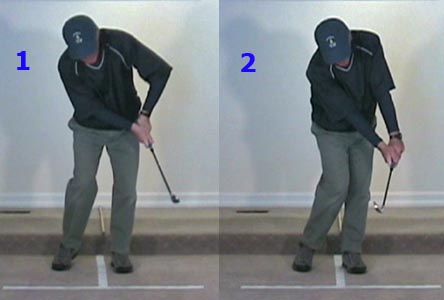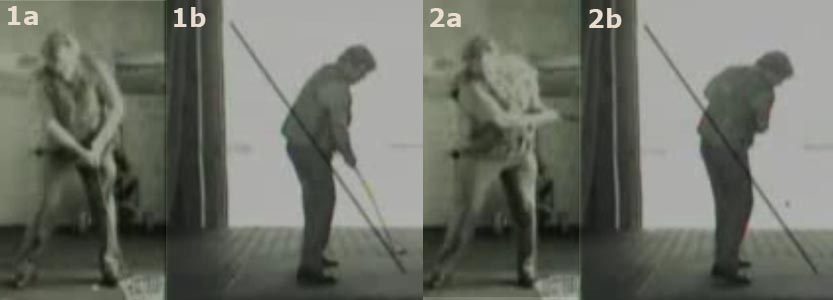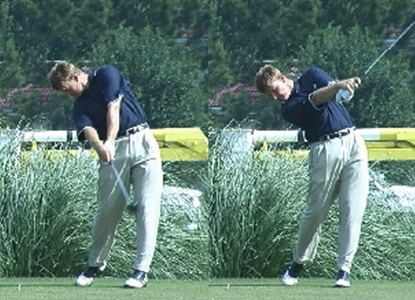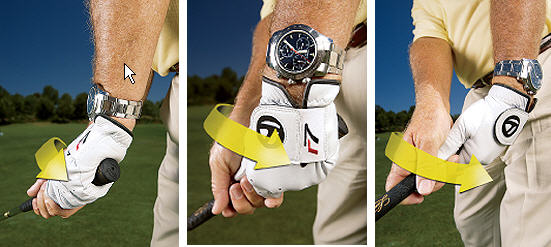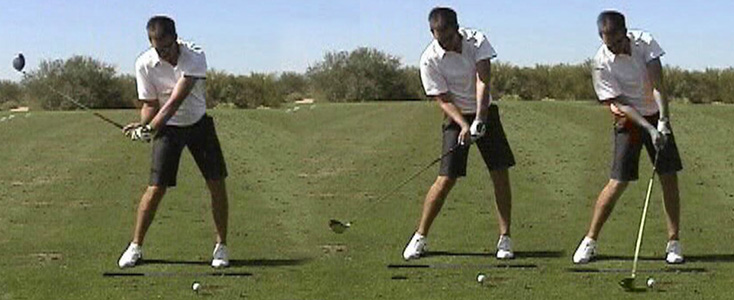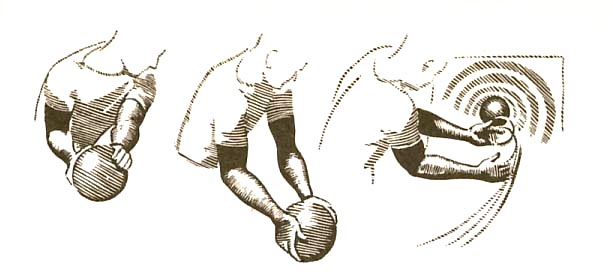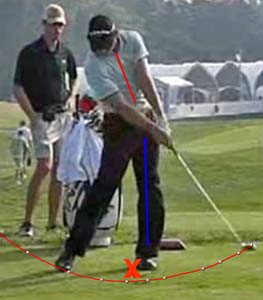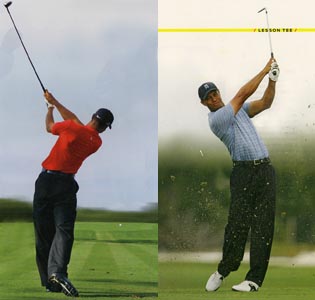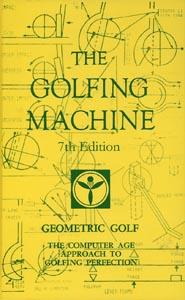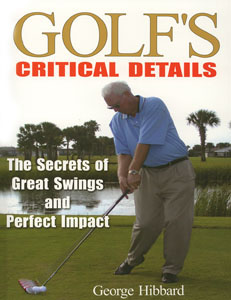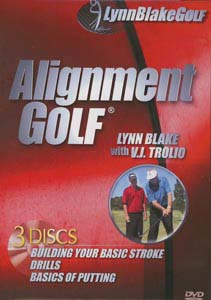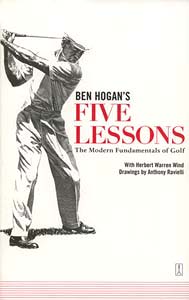How to Move the Arms, Wrists, and Hands in the Golf Swing
Click here to go back to the index page.
Introduction
This review paper is primarily focused on the optimum method of moving the arms, wrists and hands in the full golf swing. However, it also covers many other backswing and downswing body motions and it represents my latest thinking on how best to execute the full golf swing - particularly the backswing and downswing. When I started my website over 2 years ago, I decided to summarise the golf instructional material of famous golf teachers who taught the traditional golf swing. I divided the golf instructional material into separate chapters (eg. grip, address position, backswing, downswing, etc.) and I hoped that my many chapters would be an useful free educational resource for beginner golfers. Since that time, my knowledge regarding the golf swing has increased tremendously and I have developed an entirely new approach on how best to describe the performance of a full golf swing. In this review paper, I will describe my new approach, which is based on a much better understanding of the geometry, physics, mechanics and biomechanics of the golf swing. I started studying "The Golfing Machine" book [1] in April 2008 and I have spent a few hundred hours studying TGM-related material. This review paper is significantly influenced by ideas that I learnt from the TGM manual and other TGM resources. However, I do not regard myself a TGM expert and I am not an authorised TGM instructor. I have primarily selected TGM-ideas that I think are particularly useful to my personal TGM-influenced approach to the full golf swing. I have blended the TGM material with my deep knowledge of human biomechanics and this review paper represents an amalgamation of those multiple influences.
This is the second of my TGM-influenced review papers. The first TGM-influenced review paper was on the topic of "How to Power the Golf Swing". In that review paper, I described the alternative methods of powering a golf swing, and I divided golfers into two distinct camps - swingers and hitters. In this review paper, I am mainly going to focus my full attention on the problem-issue of how best to move the clubshaft in space so that a golfer can consistently hit the ball straight. I will start off my describing the basic geometry and physics of the golf swing, which a beginner golfer needs to understand before he attempts to learn the practical biomechanics of executing the "correct" body/limb movements that will allow him to move the clubshaft in space in a consistently precise manner. I also believe that if a golfer understands and executes the golf swing in the "correct" manner, that he will have learnt how to have "educated hands". The term "educated hands" refers to the TGM-concept of learning how to move your arms/forearms/wrists/hands in space in such a way that a golfer knows exactly what he is doing with each limb part during every moment of the swing. Nothing should be left to chance! I believe that a golfer needs to learn how to move his upper limbs in a precise manner, that is geometrically, mechanically, and biomechanically sound.
The TGM manual describes many methods of putting together different swing components in order to perform a full golf swing and I have chosen a particular approach that I think is the most rational method of performing a full golf swing. In a certain sense, my personal approach can be perceived to be entirely arbitrary and didactic. I therefore encourage all website visitors to be skeptical, and to use independent judgement when considering my personal approach to the golf swing. I have provided extensive details on my geometrically, mechanically and biomechanically sound method of executing a golf swing in this review paper, and I think that my particular approach will withstand intense intellectual scrutiny. However, website visitors are not obliged to accept my personal approach. Each website visitor should think deeply about my particular approach and independently decide whether my thinking/arguments are rational (or not), and whether my particular approach is worth emulating. I have spent thousands of hours thinking about this problem-issue over the past few years, because I wanted to develop a golf swing that is mechanically and biomechanically sound, and that is easy to learn and execute. I hope that website visitors will agree, after they read this review paper, that I may have achieved my goal.
Prior to writing this review paper, I produced a 96 minute swing video lesson on "How to Move the Arms, Wrists and Hands in the Golf Swing". That swing video lesson can be viewed as a stand-alone video lesson, but golfers will obtain the maximum benefit if they view that swing video lesson and also read this review paper. I have posted the swing video lesson on U-tube, and because U-tube doesn't allow one to post video segments that last longer than 10 minutes, I divided the swing video lesson into 13 segments, and a viewer needs to view the 13 segments in sequence. I have listed the 13 segments here, but a viewer can simply start with segment 1 and then move on to segment 2, which will be listed under my U-tube name - Imperfect Golfer. In other words, a viewer can view all 13 segments without coming back to this webpage in order to click on further links.
Segment 1 http://www.youtube.com/watch?v=b_ocHVG9x8o
Segment 2 http://www.youtube.com/watch?v=MGrcsc-ATjc
Segment 3 http://www.youtube.com/watch?v=GIf8CxPA8MI
Segment 4 http://www.youtube.com/watch?v=DsScQz66wMc
Segment 5 http://www.youtube.com/watch?v=AuEPed8B0kw
Segment 6 http://www.youtube.com/watch?v=c9OQevIZS38
Segment 7 http://www.youtube.com/watch?v=DOlhnUpqxHI
Segment 8 http://www.youtube.com/watch?v=ujMlNdry3LI
Segment 9 http://www.youtube.com/watch?v=c8jlEze89i8
Segment 10 http://www.youtube.com/watch?v=tsrWSd5AUBs
Segment 11 http://www.youtube.com/watch?v=vnywuZo4bTs
Segment 12 http://www.youtube.com/watch?v=Eks8MQIm-B8
Segment 13 http://www.youtube.com/watch?v=6JlPMshObJo
A viewer should note that I am 60 years old and not very flexible. I therefore cannot perform all the required body/limb movements correctly. A viewer should therefore pay strict attention to what I am describing, and emulate my verbal descriptions, and not my visually-apparent motions. I made a few verbal slip-of-the-tongue errors during the video lesson, and I occasionally stated "left" when I meant "right" etc. The total number of slip-of-the-tongue- errors was small, so I am not formally listing the statement-errors in this review paper.
Important advance notice - I have used many TGM-terms (eg. power accumulator) in this review paper. I would therefore advise readers to first read my How to Power the Golf Swing review paper before they read this review paper - so that they can clearly understand the TGM power accumulator loading and release concepts [1].
The mechanics and geometry of a full golf swing
The fundamental purpose of a golf swing is to get the clubface to be square to the target at the moment of ball-clubface separation (and I will henceforth use the term "impact"as being synonomous with the term "ball-clubface separation" to make things easier to understand) so that the ball can be hit directly towards the target. In other words, a golfer not only needs to strike the ball with sufficient force to provide the ball with enough energy to reach the desired target, the ball must also be struck with a square clubface so that the ball will travel in a straight line direction towards the target. That straight line direction represents the desired straight ball flight line, and also represents the ball-target line. If a golfer stands square to the ball-target line (parallel to the ball-target line) then he is going to be swinging the club with his arms in a sideways action across the front of his body, while his body rotates in space. To get the clubface to be square at impact, the clubshaft must swing in a rounded arc so that the clubhead approaches the ball from the inside. It must then become square at impact before moving inside again. In other words, the clubhead's movement must be in-to-square-to-in - as demonstrated in the following photograph.
Kevin Na's clubhead arc - capture image from a swing video
I used a spline tool in my swing analyer program to trace the clubhead movement in Kevin Na's swing. Note that the clubhead transcribes a rounded arc in space and the movement of the clubhead is in-to-square-to-in as it travels through the impact zone (the impact zone can be roughly described as the zone between the 3rd parallel and the 4th parallel positions - basically when the clubhead is traveling below waist level in the downswing and followthrough phase of the swing). The clubhead (and therefore clubface) is quare to the target (clubface facing the target) at only one moment in time - and that's the exact moment of impact (exact moment of ball-clubface separation if I want to be pedantically correct). The clubhead never travels in a straight line. A golfer should never attempt to "steer" the golf club - "steering" is a TGM term used to describe a deliberate action where a golfer wants to move the clubhead out of its natural arc of travel so that the clubhead can momentarily travel in a straight line. Many beginner golfers attempt to steer the clubhead in a straight line direction towards the target when the clubhead approaches the ball in the downswing by using hand manipulations of the club in the impact zone. A golfer should never attempt to steer the club by using hand manipulations - in order to hit the ball straight. A golfer must have a "fixed" idea in his mind that he is going to swing the club in a rounded arc around the body, so that the clubhead movement is going to be in-to-square-to-in. The rounded clubhead arc must never be in-to-out or out-to-in if the golfer wants to hit the ball straight. Occasionally a golfer may use alternative clubhead swingpaths to shape the ball's flight - to deliberately hit draws and fades. However, the standard clubhead swing path must be in-to-square-to-in - as demonstrated in the above photograph.Note another aspect of the rounded arc of the club's movement in space. The rounded arc is at an angle to the ground - and it appears as if the rounded arc is lying on a flat plane that is at angle to the ground. That is a characteristic feature of a golf swing - the golf club is swung around the body at an inclined angle relative to the ground. The angle is determined by the golf club manufacturers when they manufacture the golf club - they set the clubhead at an angle to the clubshaft. A golfer needs to get the bottom of the clubhead parallel to the ground at the bottom of the swing, and when the clubhead is in that position, the clubshaft will be angled to the ground - and that angle represents the angle of the inclined plane, which is the desired plane of clubshaft movement during its passage through the impact zone.
Here is a photograph of the author demonstrating the concept of an inclined plane.
Author demonstrating the concept of an inclined plane - capture images from his swing video lesson
Image 1 shows the club's position at address. The author is using a child's short club for demonstration purposes - so the clubhead doesn't reach the ground. Note that the bottom of the clubhead is parallel to the ground, and that when that condition is met, the clubshaft is angled relative to the ground. The white board (and yellow line) represents the angle of the clubshaft relative to the ground. Conceptually, the white board represents the inclined plane on which the clubshaft should travel during its passage through the impact zone. The angle of the inclined plane (relative to the ground) varies depending on the golf club - it is steeper with short irons and is at its flattest angle with a driver (because the clubshaft length of a driver is longer).
Image 2 shows the clubhead approaching the ball during the downswing. The clubhead is moving down-and-out-and-forward towards impact, and the clubshaft is traveling parallel to the inclined plane. If the clubshaft is traveling parallel to the inclined plane board (as if it is lying continuously against the surface of the inclined plane board) then the clubshaft is traveling on-plane. Note that when the clubshaft is on-plane, that the end of the club nearest the ground (clubhead end of the club) points at the ball-target line (red arrowed line). When a golfer gets the clubshaft to travel on-plane so that the peripheral end of the club points at the ball-target line (which is also the base of the inclined plane), then it can be said that the golfer is tracing the straight plane line. The straight plane line (SPL) is a mental image that a golfer must hold in his mind (blue dotted line) and the SPL is usually the ball-target line and also the baseline of the inclined plane.
Image 3 - shows the position of the clubshaft post-impact. Note that the clubshaft is still on-plane - it is traveling parallel to the inclined plane board and it is tracing the SPL (the peripheral end of the club is pointing at the ball-target line).
In other words, if a golfer wants to hit the ball straight, he must not only move the club along an in-to-square-to-in arc, he must also ensure that the clubshaft is always on-plane as it travels through the impact zone.
From a theoretical perspective, the only time that the clubshaft really needs to be on-plane is during that time period when the clubshaft approaches impact, is at impact, and during the immediate post-impact time period (the clubshaft arc time period transcribed by combining images 2 and 3 in the above composite photo). Theoretically, it doesn't matter what the clubshaft's angle is relative to the ground during the remainder of the swing - as long as the clubshaft gets on-plane during its passage through the impact zone. Jim Furyk has a distinctly-recognisable looped clubshaft swing path, where he takes the clubshaft upwards along a very steep inclined path during the backswing, and he then loops the club backwards towards the tush line in a distinctive looping motion during the early-mid downswing so that he can eventually get the clubshaft to approach the ball from the inside in the later downswing. I personally think that it is much easier to think of simply taking the club back along a selected inclined path during the backswing, and then bringing the clubshaft back down that same inclined path during the downswing.
Here is an example of a golfer who swings the club along the same inclined path during the backswing and the downswing - and this is the approach that I have personally adopted, and that I also arbitrarily and didactically recommend in this review paper. I think that it is a much simpler way of swinging a golf club and it avoids any unnecessary looping motions of the hands and/or club.
Aaron Baddeley's clubhead swing path - capture images from a swing video [2]
Note that the clubhead transcribes an arc in space during the backswing and downswing, and that the arc is along the same inclined path during both the backswing and downswing.
Now, although the clubhead travels along the same arced path during the backswing and downswing, the clubshaft's movements are not exactly along the same inclined plane during the lower half of the backswing/downswing compared to the upper half of the backswing/downswing.
Here's a composite photograph showing the position of Aaron Baddeley's clubshaft at different time points in his swing.
Clubshaft planes - using Aaron Baddeley as a model golfer [2]
At address (image 1), Aaron Baddeley's hands and clubshaft are on the hand plane. During the backswing, the clubshaft must move up along a steeper clubshaft inclined plane so that it can end up just above the right shoulder plane at the end of the backswing (image 2). The right shoulder plane is also called the turned shoulder plane - and its inclined angle relative to the ground is represented by a straight line drawn from the right shoulder (at its end-backswing position) to the ball-target line. During the downswing, the clubshaft descends to a less steep plane and at impact it is on the elbow plane. The elbow plane is an inclined plane represented by a straight line drawn between the right elbow and the ball-target line - when the golfer is at impact (image 3).In other words, the clubshaft is undergoing a double plane shift during the backswing/downswing. During the backswing the clubshaft is shifting planes from the hand plane to the turned shoulder plane, and during the downswing the clubshaft is shifting planes from the turned shoulder plane to the elbow plane. I previously mentioned that the clubshaft must be "on-plane" during its passage through the impact zone, and I defined an on-plane clubshaft motion as a clubshaft motion where the clubshaft is always lying along the inclined plane represented by the elbow plane line. When the clubshaft is traveling on-plane on the elbow plane through the impact zone, the peripheral end of the club always traces the SPL (the peripheral end of the clubshaft always points at the ball-target line).
Now, to make matters slightly more complex, a golfer needs to understand that I also think that the clubshaft should remain on-plane during the entire backswing and entire downswing - even while it is shifting planes. That sounds like a contradiction - how can the clubshaft stay on-plane while it is shifting planes? To understand that point, a golfer needs to understand the "on-plane" concept from a different perspective.
Homer Kelley stated in his TGM book [1] that a clubshaft is deemed to be on-plane if the end of the club nearest the ground always points at the base of the inclined plane (which is usually the ball-target line), and that the only time that this condition need not be met is when the clubshaft is parallel to the base of the inclined plane (ball-target line). The clubshaft usually becomes parallel to the ball-target line at four time points during an ideal on-plane swing - i) at the end of the takeaway (first parallel); ii) at the end-backswing position (second parallel); iii) at the delivery position (third parallel); and iv) during the early finish phase (fourth parallel). At all other time points, the end of the clubshaft (the end of the club that is nearest to the ground) must point at the ball-target line (or an imaginary extension of the ball-target line).
Here is an example of a perfect on-plane clubshaft motion during the downswing - Anthony Kim's swing [3].
Anthony Kim's on-plane clubshaft motion - capture images from a swing video
Image 1 (end-backswing) and image 5 (delivery position) demonstrate that his clubshaft is parallel to the ball-target line. At all other time points, the end of the club nearest the ground (*butt end of the club in images 2, 3, 4 and clubhead end of the club in images 6, 7) points at the ball-target line (yellow dotted lines). Anthony Kim's swing is a perfect example of a swing where the clubshaft is always on-plane - even when it is shifting planes from the turned shoulder plane (at the end-backswing) to the elbow plane (at impact). While it is shifting planes, it also fulfills Homer Kelley's definition of being on-plane [1].(* It is important to understand that when drawing those dotted yellow lines, I am mentally projecting where the peripheral end of the club is likely pointing, and it is pointing out-of-the photo in images 2 and 6, and into-the-photo in image 4, and it is only parallel to the front of the camera lens in image 3)
In my swing video lesson, I demonstrate an on-plane clubshaft movement when using a short club, and also when using a dowel stick. I think that every serious golfer needs to train himself to consistently achieve an on-plane clubshaft motion during both the backswing and downswing, and in the next section of this review paper I am going to describe all the necessary hand, wrist, forearm, elbow and arm motions that are needed to keep the clubshaft on-plane during both the backswing and downswing.
Biomechanics of the backswing - hand, wrist, forearm, elbow and arm motions needed to keep the clubshaft on-plane during the entire backswing
In this section, I am going to describe a practical method of moving the upper limbs in space, so that one can consistently keep the clubshaft on-plane during both the backswing and downswing.
I have spent hundreds of hours trying to think of a simple method of moving the upper limbs in space so that a golfer can develop a consistent on-plane swing, and I have finally developed a simple method of achieving that goal. It is amazingly simple when you eventually understand the process, and it will allow you to develop a consistent on-plane swing that doesn't vary from swing-to-swing. One of my fundamental principles is a belief that the upper limb and body motions must be biomechanically natural and comfortable, and that one shouldn't have to force the arms/body to move in an unnatural manner.
Right upper limb motion
Here is how the process of learning this on-plane swing starts - one starts off by focusing all one's attention on the right upper limb. I believe that if a golfer learns how to move the right upper limb in space in the "correct" manner, that it will allow him to keep the clubshaft on-plane throughout the entire swing (backswing and downswing). The left upper limb simply has to follow the lead of the right upper limb and follow its directional movements in space.
Right clap hand action
The learning process starts off by getting into a clap hands position. This is harder to describe than to demonstrate - so I recommend that every reader also view my swing video lesson to acquire a maximally clear understanding of the clap hands process.
Author demonstrating the address position for the clapping hands drill
The above capture image fom my swing video lesson demonstrates how one gets into the address position to start the clap hands drill. The posture is identical to the address posture a golfer should adopt at address, except that there is no golf club and the palms of the hands are facing each other - ready to start a hand clapping action. The action of hand clapping is a very natural action that requires no instructional guidance. It is natural action that all healthy human beings can perform without having to consciously think about the biomechanical process. During the action of hand clapping one maintains the small amount of wrist bend that one has at address, and one simply externally rotates the humerus (upper arm) in the shoulder socket joint while allowing to the elbows to naturally bend slightly more during the clap hand action. Note that when performing the clap hands drill with both hands that both forearms fan out naturally as the upper arms externally rotate at the level of the shoulder joints.After getting the "feel" of the clap hand motion, keep the left hand motionless, and only perform the clap hands drill with the right upper limb.

Author demonstrating the "clap hands" drill using only the right hand - capture images from his swing video lesson
Image 1 shows the right upper limb moving in space while performing the clap hands action. Note how the right upper arm naturally moves away from the torso during the action, and note how the right forearm fans out.Image 2 shows the back-limit of the right hand clap action if one doesn't allow the upper and lower torso to move. In other words, I cannot get my right hand further back than that position if I keep my lower and upper torso square to the ball-target line.
Image 3/4 shows how far the right hand can go back if I allow my upper and lower torso to rotate freely (to about a 45 degrees pelvic rotation and a 80-90 degrees shoulder rotation) while performing the right clap hand action. Note that the right hand ends up behind the right shoulder with the right forearm vertical to the ground if one allows the right elbow to bend to a ~90 degree angle during this action. If a golfer has the flexibility to get to that position where the right hand is behind the right shoulder then that represents a good end-backswing position. Note that the right palm and ventral surface of the right forearm is facing the camera in image 4. That is not really the correct end-backswing position of the right forearm/palm in a "real" golf swing because the ulnar border of the right forearm will be facing the camera at the end-backswing position - when the left arm is pulled across the upper chest wall by the right hand. The left arm will act as a checkrein that limits how far the right hand can move back secondary to external rotation of the right humerus in the right shoulder joint. The basic purpose of this right clap hand movement is merely a simple way of giving a beginner golfer an easy-to-understand sense of how the right upper limb moves in space during a right forearm takeaway maneuver - where the right forearm movement is solely due to external rotation of the right humerus in the right shoulder joint (while the right shoulder is moving back due to torso rotation).
Each individual reader/viewer (if he is not physically handcapped) should be able to perform this right hand clap action easily and naturally and the right hand should always follow the same path to its same final position (desired destination point) behind the right shoulder. The only variation that could occur would be due to varying amounts of upper/lower torso rotation occurring in the late backstroke action from one right clap hand drill to the next clap hand drill. However, that should not occur if a golfer moves the right upper limb first and allows the torso to be passively pulled back in a rotary maneuver secondary to the pulling motion coming from the right upper limb trying to get further back. In other words, a golfer should be able to repeat this drill endlesssly and the right hand/forearm/elbow/arm should each follow exactly the same path going up, and the same path coming down. After a golfer has perfected this motion, so that it is endlessly repeatable in a very consistent manner, then he should move on to the next step of the learning process.
Right wrist motion
The next step in the process of learning how to move the right upper limb in space - so that one can keep the clubshaft constantly on-plane throughout the entire backswing - is to learn how the right wrist must move during the backswing.
I demonstrate how the right wrist must move in my swing video lesson - using a dowel stick (48" in length and 5/8th inch in diameter). I highly recommend that every golfer consider purchasing a wooden dowel stick because it is an extremely useful learning tool.
Consider how the right hand sits on the golf club at address.
Author demonstrating the position of the right hand at address
In the above capture image from my swing video lesson, I am demonstrating how the right hand sits on the golf club at address. Normally, the clubshaft is at angle to the ground at address - the clubshaft lies on an inclined plane, and for most golfers that inclined plane is either the hand plane or the elbow plane. When a golfer adopts his grip, he should first grip the grip end of the club with his left hand. He should then place the lifeline of the palm of the right hand over the left thumb, and then grip the club with the 3rd and 4th fingers of the right hand. The right 5th finger usually rests in a groove between the left 4th and 5th fingers (when using a Vardon grip). The right 2nd finger and right thumb grip the club in a pincer way (see my chapter on the grip for further details). The palm of the right hand should face the target, and the right palm should be parallel to the left palm across the grip.Most importantly, the right wrist must be level at address - a straight line drawn along the radial border of the right forearm must be in line with the radial border of the right index finger (see yellow dotted line in the above photograph). If the right wrist is level - then the central end of the dowel stick should be roughly in line with the right forearm (see above photograph). In other words, the right wrist must be neither upcocked or uncocked at address. The right wrist must be level, or close to level, at address (see the wrist glossary for a description of wrist movements).
Now, the key movement regarding the right wrist is that the right wrist must bend backwards (dorsiflex) during the right upper limb's clap hand action - while remaining level. In other words, the right wrist only bends back during the backswing, and it should never be allowed to upcock during the backswing's clap hand action. By keeping the right wrist always level while it is bending back during the right clap hand action, a golfer will be able to keep the clubshaft always on-plane during the entire backswing.
Author demonstrating the clubshaft's on-plane movement during the backswing
The above photo series shows the author demonstrating how the clubshaft remains on-plane during the entire backswing if two conditions are met - i) the right upper limb performs a natural clap hand action, and ii) the right wrist remains level. Note how the central end of the dowel stick (blue dotted line) is always in-line with the right forearm (red dotted line) throughout the entire backswing - indicating that the right wrist has remained level. At no time point during the backswing should a golfer allow the right wrist to upcock, because that will cause the clubshaft to move off-plane.Body motion - synchronised with the right upper limb motion
Those two right upper limb actions - i) right clap hand action and ii) right wrist bending back action while keeping the right wrist level - are the only two right upper limb actions that a golfer needs to learn in order to keep the clubshaft on-plane during the entire backswing. The third step in this learning process is integrating the movement of the right upper limb with a controlled rotation of the upper and lower torso.
Takeaway - I think that the first step in integrating these movements is to start the takeaway with a right clap hand action movement. During the first few moments of performing a right clap hand action, a golfer should feel that the back of the right hand moves straight back (away from the target) and that the right forearm is moving nearly horizontally (roughly parallel to the hand/elbow plane) - this action represents the right forearm takeaway.
A right forearm takeaway causes the clubshaft to remain on-plane (moving along the surface of a hypothetical inclined plane board) and it causes the clubhead to move immediately back-and-up-and-inside. The clubhead must not be kept low to the ground or "steered" in a straight line along the ball-target line - these are artificial "steering" actions that cause the clubhead to move off-plane.
A good technique of ensuring that the clubshaft is moving on-plane at the start of the takeaway is to ensure that PP#3 (right index finger where it abuts the back of the grip end of the club) traces a straight plane line (SPL) at the start of the backswing. The SPL is the base of the inclined plane and also the ball-target line. When PP#3 traces the SPL, one is referring to an imaginary straight line between PP#3 and the clubface sweetspot (center of the front of the clubhead) and that imaginary straight line should always point at the base of the inclined plane (ball-target line) during the takeaway. To understand this point, consider this photo sequence of Stuart Appleby's takeaway - from the following swing video http://www.youtube.com/watch?v=_jqJ9R2LypY
Stuart Appleby's right forearm takeaway - capture images from a swing video
Note that Stuart Appleby has his right forearm (blue line) nearly straight-in-line with the clubshaft at address (image 1) and that it is parallel to the elbow plane line (white line). Note that you can see the left forearm in this down-the-line view (yellow line in image 2), which means that the left forearm is closer to the ball-target line (higher) than the right forearm at address. Note that the right forearm moves straight back in the early takeaway (and this is called the right forearm takeaway). Note that the peripheral end of the club, and PP#3, points at the ball-target line (red arrows). When PP#3 and the peripheral end of the clubshaft points at the ball-target line (which is the base of the inclined plane), it is called tracing the straight plane line. When the right forearm moves parallel to the elbow plane in the takeaway, it allows PP#3 to trace a SPL and it allows the clubshaft to be on-plane. Note that the right elbow starts to fold during the early takeaway. I now believe that it is a mistake to keep both arms rigidly straight during the takeaway (one-piece takeaway) - an idea that is promulgated by so many golf instructors (and that is described in my backswing chapter). I think that the right forearm takeaway is a much better method of keeping the clubshaft on-plane during the backswing.
After the right hand has moved back about 6-12" the right hand should definitely be moving inwards-backwards and the right forearm should be fanning opening - the natural clap hand action, that is due to external rotation of the right humerus in the right shoulder socket joint. There should never be a "feeling" of steering the club during the takeaway. After the clubhead has moved back about a few inches (while moving upwards and inwards) the golfer needs to allow the shoulders to turn back in synchrony with the moving right upper limb. Each individual golfer needs to practice this maneuver with a dowel stick to get a "feeling" of how fast to rotate the shoulders while performing the right clap hand action - by monitoring the on-plane movements of the clubshaft. A student golfer needs to perform this backswing takeaway action in slow motion to learn the process while looking-looking-looking at both ends of the dowel stick to make sure that the end of the dowel stick that is nearest the ground (peripheral end before reaching the first parallel position, and central end after passing the first parallel position) always points at the ball-target line. If one rotates the torso too fast (relative to the degree of right clap hand action movement) then the clubshaft will move inside too fast and the clubshaft will go off plane. Only through practice with a dowel stick (or golf club), can a beginner golfer learn how to synchronise the movement of the right upper limb with the rotation of the torso. During the backswing, the slightly flexed right knee should remain "fixedly" flexed to discourage any swaying motions of the pelvis, but the pelvis must be allowed to rotate back freely in response to the "need" of the right hand to get back to its desired end-backswing position - a positional point behind the right shoulder (or opposite the right shoulder if a golfer is inflexible). I think that it is a mistake to restrict the pelvic rotation in order to increase the degree of torso-pelvic separation (degree of static X-factor) at the end-backswing position. For most golfers, the pelvis should rotate about 45-50 degrees in the backswing, and the shoulders should rotate about 80-90 degrees to allow the right hand to end up at its desired location. The key point in the kinetic sequencing process is that the right upper limb should move first, then the shoulders and finally the hips - as demonstrated by the author in the swing video lesson. The second key point is that the relative speed of movement of each body part is dictated by the need to keep the clubshaft on-plane at every time point during the entire backswing. Once a beginner golfer has practiced this maneuver with a dowel stick at home, then it should become second nature and automatic and deeply ingrained in his brain, and every repeat backswing action should enable the golfer to consistently perform the identical right upper limb/torso movements that allows the clubshaft to remain on-plane throughout the entire backswing. Note that the shoulders should rotate relatively horizontally around the bent-over spine and one should not attempt to tilt the left shoulder groundwards during the rotation of the upper torso around the bent-over spine.
Once a beginner golfer has perfected his right upper limb motion, then he can proceed to learn how to move the left upper limb in space during the backswing.
Left upper limb motion
The fundamental rule regarding the left wrist is that the left wrist must remain flat throughout the entire backswing and downswing. The left wrist must never bend at any time point during the swing - no forward bending (dorsiflexion) or back bending (palmar flexion) at any time point during the backswing/downswing. The only movement that should occur at the level of the left wrist is a cocking motion - an upcocking motion that causes the left arm and clubshaft to establish a 90 degree angle by the top of the backswing. Then, during the downswing, the left wrist will uncock to a level wrist position at impact (neither upcocked or downcocked, and neither dorsiflexed or palmar flexed) - the left wrist must be level and flat at impact.
Consider the concept of the left arm flying wedge.
Author demonstrating the motion of the left arm flying wedge during the backswing - capture images from his swing video lesson
Image 1 shows the position of the left hand and clubshaft at address. Note that there is an angle between the left arm and the clubshaft (yellow dotted lines) and that the left arm and clubshaft are not in a straight line relationship. That is due to the fact that the golfer's left hand holds the club's grip in the fingers (like holding a hammer), where the grip end of the club lies across the lower palm below the heel pad (hypothenar eminence). If a golfer held the club in the mid-palm along the lifeline of the left palm (with the clubshaft lying above the heel pad), then the clubshaft and left arm would form a straight line relationship - and that type of palm grip should be avoided for a full golf swing. The acute angle between the left arm and the clubshaft gives the left arm-clubshaft relationship the visual appearance of a wedge-shaped structure, and the left arm-clubshaft wedge structure is therefore called the left arm flying wedge structure [1] ("flying" because that structure flies in space like a V-shaped airplane). During the backswing the left arm flying wedge is going to fly up to the end-backswing position, and during this process the only motional action that is going to occur within the left arm flying wedge structure is an increased amount of left wrist upcocking - so that the left wrist will be cocked to a 90 degree angle by the end of the backswing.At the start of the takeaway, the back of the left hand (and watchface on the back of the flat left wrist) will be facing the target. Then during the backswing, the straight left arm flying wedge unit will rotate clockwise (as viewed from above) so that the back of the left hand (and watchface on the back of the flat left wrist) will be facing significantly skywards at the end of the backswing. During this left arm rotational movement, the left wrist must always remain geometrically flat.
Images 2 and 3 demonstrates how the straight left arm rotates clockwise during the backswing. The rotation of the left arm is mainly due to internal rotation of the left humerus at the level of the left shoulder socket and this process is made easier due to the fact that the left shoulder socket simultaneously moves down-and-out-and-backwards during the backswing (image 3). There is also a small amount of independent left forearm pronatory movement occurring during the takeaway - while the left arm unit is rotating clockwise - and that allows the toe of the club to point straight-up at the end of the takeaway in a swinger (image 2). In a hitter, this independent left forearm pronatory motion doesn't occur to the same degree due to the use of a "twistaway" maneuver and the clubface should be slightly closed at the end of the takeaway (see my How to Power the Golf Swing review paper for further details on the difference in left wrist movements between swingers and hitters).
A beginner golfer may ask two relevant questions - i) when and how fast should the left arm/forearm rotate clockwise during the backswing and ii) when and how fast should the left wrist upcock during the backswing. The answer is simple! A golfer doesn't need to consciously think about this problem, because the left hand simply follows the "directions" established by the right hand. The right hand essentially carries the left hand (and therefore clubshaft) to the end of the backswing - while the right upper limb's movements in space ensures that the clubshaft is always on-plane. The right hand's movements in space are dictated by the synchronous interaction between the right clap hand manuever that moves the right arm and forearm in a certain direction at a certain speed, while the right wrist inceasingly bends more backwards during the backswing (while always remaining level). The left hand has no choice but to move with the right hand, and therefore the right hand's movement in space dictates when and how fast the left wrist upcocks, and when and how fast the left arm/forearm rotates. A golfer only needs to let this happen naturally without offering any impedance to this automatic/natural biomechanical phenomenon.
In my How to Power the Golf Swing review paper, I discussed the issue of extensor action. It is important that a golfer understands, and correctly applies extensor action throughout the backswing and downswing.
Author demonstrating extensor action force - capture images from his swing video lesson
In my How to Power the Golf Swing video lesson, you can see that my left arm bends readily at the left elbow joint when I swing the small, lightweighted club with my left arm alone (image 1). That's because I am resisting any tendency to "artificially" straighten my left arm by tensing up the muscles of my left arm. However, when I swing with both arms, you can see that I can more readily keep my left arm straight by applying an extensor action force at pressure point #1 (image 2).
Pressure point #1 and #3 - modifed image from reference number [4]
Extensor action is applied continuously throughout the backswing if a golfer gently attempts to straighten the right elbow - even while the right elbow is folding during the backswing. As one attempts to gently straighten the right elbow by contracting the right triceps muscle at the back of the right arm, this muscle action causes the right hand to push down on the left thumb at PP#1 and that gentle push-force on the back of the left thumb pulls the left arm straight.
A golfer needs to continuously maintain extensor action while performing the right clap hand maneuver. This doesn't significantly change the direction of the right clap hand movement in space, other than causing the right upper arm to move slightly further away from the torso during the backswing, thereby slightly widening the arc of motion of the right upper limb in space.
A golfer must learn to have a distinct "feeling" that the right hand is carrying the left hand to the "correct" end of the backswing position, and the right hand can therefore be considered to be controlling the left/right hand arc's directional movement in space - while the clubshaft is kept on-plane.
It is important that a golfer learns to understand what position represents a "correct" position at the end of the backswing.
End backswing position
As a general rule, if a golfer performs the right clap hand motion correctly during the backswing, while bending the level right wrist back, then the hands (and grip end of the club) should end up somewhere near the right shoulder, or slightly behind the right shoulder, by the end of the backswing.
Consider where the author's right hand ends up if he performs the right upper limb motion correctly (as previously described).

Author demonstrating the position of the hands at the end/top of the backswing - capture images from his swing video lesson
In image 1, I have tied a string around my left shoulder and one can see the straight/taut string's position at the end of the backswing (just above the red dotted line). I used a string because I am not flexible enough to get to that end-of-the-backswing position using my left arm (instead of the string). At the end-of-the-backswing position, the clubshaft is roughly parallel to the ball-target line, and the right hand is behind and slightly higher than the right shoulder. Note that the string (equivalent to the left arm) and the clubshaft form a 90 degree angle, and that wedge-shaped angle is the left arm flying wedge's angle at the end of the backswing. Note that the right wrist is significantly bent back (significantly dorsiflexed) and that the right forearm is at an angle to the back of the bent right wrist. That angle represents a wedge-like structure, and that wedge-structure is called the right forearm flying wedge [1]. Note that the right forearm is roughly perpendicular to the clubshaft and therefore close to a 90 degree angle to the left arm flying wedge. In other words, the right forearm flying wedge nearly has a 90 degree angular relationship to the left arm flying wedge. That nearly 90 degree spatial relationship defines a "correct" position at the end of the backswing. One can think of the left arm flying wedge structure as an airplane wing, and the right forearm flying wedge as a strut that supports the airplane wing. The actual angle of the right forearm relative to the left arm flying wedge depends on the degree of right wrist bend at the end-backswing position - and it can only be close to 90 degrees if the right wrist bends at a 90 degree angle. The right wrist bend is usually far less than a 90 degree angle in most golfers, and it should be roughly equal to the amount of right wrist bend that a golfer is going to have at impact.Image 2 shows the top-of-the-backswing position - where the hands are opposite the right shoulder. The top-of-the-backswing position is merely equivalent to a slightly shortened backswing. Many tour professional golfers prefer to have a slightly shortened backswing where the hands do not get further back than a position opposite the right shoulder (rather than getting to a position behind the right shoulder). Note that the right forearm (yellow dotted line) is nearly at right angles to the left arm flying wedge (red dotted line) - and that defines a "correct" top-of-the-backswing position. Note that the right forearm is angled relative to the ground and that it is not vertical to the ground (like the right forearm in image 1). That is irrelevant - the right forearm's angle to the ground has no relevance, and the direction the right elbow is pointing at also has no relevance. The only important relationship is the nearly 90 degree relationship between the left arm flying wedge and the right forearm flying wedge (the actual angle depending on the degree of right wrist bend).
Image 3 shows the author in his usual top-of-the-backswing position. When I play golf I bend over slightly more at the waist (compared to image 2 where I was deliberately standing more erect to face the camera), and in that bent-over posture I do not have the flexibility to get my left hand as far back as a position opposite the right shoulder. My hands are marginally ahead of my right shoulder (as seen from a down-the-line view). Then, when I acquire close to a 90 degree relationship between the right forearm flying wedge and the left arm flying wedge, my right elbow points more backwards (often called a "flying right elbow"). That doesn't matter very much as long as I have acquired the "correct" angular relationship between the left arm flying wedge and the right forearm flying wedge - while keeping the clubshaft on-plane (butt end of the club points at a point that is located on an extension of the ball-target line). When the clubshaft is on-plane, the back of the flat left wrist and palm of the right hand will be parallel to the clubshaft (and therefore parallel to the inclined plane), but the left arm will be angled away from the inclined plane in the direction of the left shoulder, and the right forearm will be angled away from the inclined plane - with the angle depending on the degree of right wrist bend.
So, a golfer needs to have close to a 90 degree angular relationship between the left arm flying wedge and the right forearm flying wedge at the end of his backswing - whether he gets to the end-of-the-backswing position or the top-of-the-backswing position. If a golfer gets to that "correct" position by the end of his backswing, while always being on-plane during the entire backswing, then the left arm should always be angled across the shoulder turn angle by the end of the backswing - positioned somewhere between the red dotted line and the blue dotted line in image 1. It doesn't matter if the left arm is slightly steeper than the shoulder turn angle - blue dotted line. However, it is unacceptable for the left arm to be positioned too steeply with the hands above the neck - yellow dotted line in image 1. If the left arm is positioned along such a steep angle, then it will be much more difficult to reroute the clubshaft down to the elbow plane in the mid-late downswing, and the clubshaft may descend on a too-steep angle down to the ball.
Here is a series of photos showing Stuart Appleby's arm movements during his backswing.
Stuart Appleby backswing - capture images from a swing video [5]
I have highlighted Stuart Appleby's right arm in red. Note how he starts the backswing with a right forearm takeaway that allows his right forearm and right elbow to remain very close to the elbow plane (white line) during the backswing - during the right clap hand action movement. Note that his right wrist remains level during the entire backswing. If the right wrist appears slightly upcocked at the end-backswing position due to the fact that the right wrist is maximally dorsiflexed, then that's a normal phenomenon because when the right wrist is maximally bent back (maximally dorsiflexed) it assumes a "fixed" degree of cocking position, where one cannot vary the degree of cocking of the wrist.At the end-backswing position, his clubshaft is lying along the turned shoulder plane. Note that he has a roughly 90 degree relationship between his left arm and clubshaft and that this wedge-shaped relationship represents the left arm flying wedge. Note that his right forearm is angled at slightly less than a 90 degree angle to the left arm flying wedge at the end-backswing position - and that the right forearm acts like a supporting strut underneath the left arm flying wedge.
Note how his left wrist remained flat throughout the entire backswing. Note how the left arm/forearm rotates clockwise during the backswing so that his flat left wrist can lie against, and parallel, to the turned shoulder plane at the end of his backswing. One can imagine how his right hand is carrying his left hand to the "correct" end-backswing position - while keeping the clubshaft on-plane at all time-points during the backswing.
Biomechanics of the downswing - hand, wrist, forearm, elbow and arm motions during the downswing
I have previously stated that a golfer should strive to keep the clubshaft on-plane during both the backswing and downswing, and I also stated that my arbitrary swing recommendation is to use the same hand path in both the backswing and downswing. However, that is not strictly possible because the kinetic sequence operates differently in the downswing compared to the backswing. I described the following kinetic sequence in my recommended backswing action -: Right upper limb moves first - in the form of a right forearm takeaway due to a right clap hand maneuver (carrying/pulling the left hand to its end of the backswing position) => shoulders rotate secondarily => pelvis rotates last (delayed hip turn). It is also acceptable for the pelvis to move synchronously with the shoulders as an unitary torso rotation (standard hip turn). However, the right upper limb must move first, which means that the arms/hands lead the torso.
It is important that all beginner golfers understand that this kinetic sequence, where the arms move first, and the torso moves secondarily, is inappropriate for a pivot-driven downswing where the pivot powers the swing. Most professional tour golfers use a pivot-driven swing, and that is the swing style that I recommend for most golfers who decide to become swingers (and not hitters). I described how a swinger powers the golf swing in great detail in my How to Power the Golf Swing review paper, and the major power source in a swinging action is the release of power accumulator #4.
Here is a photo sequence showing how Ben Hogan releases PA#4 - capture images in the photo sequence were derived from the following swing video.
http://www.youtube.com/watch?v=QL_6M_xZvq0
Ben Hogan's downswing sequence - capture images from a swing video
By the end of his backswing, Hogan has fully loaded power accumulator #4 (pulled his left arm across his chest wall so that he can feel a sense of pressure at PP#4 - the left pectoral area of the chest wall where it abuts the upper left arm). He has also fully assembled his power package by the end of the backswing - and the power package consists of the left arm flying wedge and the right forearm flying wedge and its supporting structural elements (right upper arm and right shoulder). Hogan then starts the downswing with a pelvic shift-rotation movement (images 1 and 3) that causes his hands to move down-and-out-and-slightly backwards - direction of the red line in image 1 and yellow arrow number 1 in image 3. Note how Hogan keeps the power package intact during the early downswing - note that the right elbow is still bent at a 90 degree angle, and note that the right forearm flying wedge still has roughly the same angular relationship to the left arm flying wedge. Note how the right ebow has been pulled down towards the right hip area. Note that the upper left arm still lies against the chest wall, which means that he must be experiencing increased loading pressure at PP#4 (left pectoral area) because his upper torso is starting to rotate forward thereby increasing loading pressure against the inner part of his inert left upper arm. In other words, the kinetic sequence in Hogan's swing starts from the bottom-up - the lower body moves first (pevic shift-rotation movement). As soon as the pelvis shift-rotates (hip squaring phase of the downswing) it causes the upper torso to start rotating and that upper torso rotation causes the right shoulder to move downplane. When the right shoulder moves downplane, and the left shoulder simultaneously moves down-and-out-and-forwards, it causes the entire power package structure (right forearm flying wedge and left arm flying wedge) to be passively pulled down as an intact unit in the direction of the ball. In other words, the "observed" hand movement seen in images 1 and 3 occurs passively and it is not due to any active attempt by the golfer to actively pull the hands down to the ball with his arms. In fact, a golfer must ingrain the opposite "feeling" in his mind. He must have the distinct "feeling" that he is attempting to leave his hands and clubshaft at the top of his swing, while he actively starts the downswing with a lower body shift-rotation movement of the pelvis. He must have the distinct "feeling" that the hands are being passively pulled down to waist level by the lower body's shift-rotation movement, and not due to any active arm/hand movements. The arms/hands should not be moving faster than the rotating torso in the early downswing, and that is why the power package assembly remains intact in the early downswing.Note what happens after Hogan's left arm gets to a position just beyond the end of the early downswing - image 1. From that point (when the shoulders reach their peak speed) onwards, Hogan starts to release PA#4 - note how the left arm starts to separate from the chest wall and note how the hands move further away from the right shoulder (yellow colored area in image 2). Hogan is not actively pulling his left arm away from his left pectoral area during this phase of the downswing by using his left shoulder girdle muscles. What actually happens is that the inert left arm is passively catapulted away from the chest wall when the pivot action subsides (when the shoulder rotation starts to decelerate in the mid-downswing). The energy used to propel the left arm towards the ball comes from the actively rotating upper torso. Although the lower body initiates the downswing, and a certain amount of energy is passively transferred to the upper body via the spine and the external torso muscles/ligaments (kinetic link theory or COAM theory), most of the energy causing the upper torso to rotate fast in the early downswing is derived from the active contraction of mid-upper torso muscles. The upper torso decelerates soon after the pelvis decelerates - and it happens when the shoulders are getting close to being parallel to the ball-target line - see image 1. After that time point, the shoulder rotation naturally decelerates, but the inert left arm continues to freewheel at a fast speed towards impact. That freewheeling left arm movement causes the hands to move down towards the ball - see the yellow arrow number 2 in image 4. Moments later the hands will be in the delivery position - where the clubshaft is parallel to the ground and also parallel to the ball-target line (image 4). Note that the right elbow is adjacent to the right hip, and note that the right elbow is still bent at a 90 degree angle, when the club is at the delivery position (third parallel position).
A key factor that causes the lower torso and then the upper torso to decelerate in the mid-downswing is the fact that the golfer is rotating his torso against the resistance of a braced (straightening) left leg - often referred to as a "firm supportive left side". If a golfer keeps the head stationary in the downswing while simultaneously bracing his left leg, then he creates a braced skeletal structure extending from the head down the spine, through the pelvis, and down the straightened left leg to the left foot - see next photo.
Hogan downswing sequence - capture images from a swing video
When Hogan starts the downswing, he shifts weight onto the left leg thereby firming up the left leg (and thereby producing a braced left side that resists further lateral shift of the pelvis). If the head is kept stationary, then there is a braced skeletal structure extending from the head, down the spine, through the pelvis, and down the left leg to the left foot - see the red lines in image 2. That braced skeletal structure slows down the rotation of the torso and induces the release of PA#4 - induces the left arm to swing freely away from the chest wall towards impact (images 3,4 and 5). A beginner golfer needs to acquire the "feeling" of stabilising the pivot action in the mid-downswing so that he can induce the "feeling" of the arms swinging freely across the front of the stationary head-stabilised torso towards impact.
Here is a diagram delineating the kinetic sequencing phases of the downswing.
Kinetic sequencing in the downswing
Rv = Rotational velocity (angular speed). Note that the pelvis starts moving first and it reaches its peak speed at the end of the early downswing. Note that the shoulders reach their peak speed shortly thereafter. When the shoulders start to decelerate in the mid-downswing, the left arm passively leaves the chest wall (release of PA#4) and freewheels towards impact. A golfer should experience a distinct "feeling" that the left arm is swinging freely across the front of the rotating torso after the release of PA#4, and that the hands are moving further-and-further away from the decelerating right shoulder. The left arm reaches its peak speed in the late downswing, and slows down just prior to impact (when PA#3 fully releases thereby causing the back of the flat left wrist/hand and clubface to face the target by impact).What allows Tiger Woods to generate a clubhead speed of 125 mph at impact when using a driver while a very good amateur golfer can only generate a clubhead speed of 100-10mph? It is not due to only one kinetic factor eg. rotating the pelvis faster. It is due to the fact that Tiger Woods can perform the entire kinetic sequence faster, and it is not due to the fact that he performs one specific part of the kinetic sequence faster. In other words, if a golfer wants to generate faster clubhead speeds, then he needs to speed-up the entire kinetic sequence while allowing the kinetic sequence to still evolve in the same optimised manner. From a swinger's perspective, the power accumulator release sequence will still occur in the same order (4:2:3) and a golfer should make no attempt to add right arm push-power at any time point in the downswing. The most important factor determining clubhead speed at impact is the speed of release of PA#4, which is determined by the speed of rotation of the upper torso. Once the left arm moves away from the chest wall (after the release of PA#4), then a golfer cannot influence further events in a beneficial manner by attempting to actively uncock the left wrist and/or by attempting to add right arm push-power in a drive loading manner to the back side of the grip end of the club in the late downswing. In fact, a key "feeling" that a swinger must learn is the "feeling" of allowing the left wrist to uncock passively/freely/automatically in response to the CF-induced release of PA#2. When the left wrist uncocks naturally/ passively in the late downswing, then the clubshaft will simply swing down towards impact at an optimal speed - depending on the efficiency of performance of the entire kinetic sequence.
What happens to the right elbow and right forearm from the delivery position to impact?
Aaron Baddeley's clubshaft descending to impact - capture image from a swing video [2]
From the delivery position, the clubshaft is going to descend on-plane (on the elbow plane) down to the ball. Note how the right elbow starts straightening during this phase of the downswing and note how the right forearm is going to paddlewheel into impact, so that the right forearm is in-line with the clubshaft, and on-plane, at impact - see next photo.
Aaron Baddeley at the impact position - capture image from a swing video [2]
Note that Aaron Baddeley's right elbow is incompletely straightened at impact. Note that the right forearm is on-plane with the clubshaft - on the elbow plane. Note that the right wrist is still bent backwards (dorsiflexed) at impact.The straightening of the right elbow is somewhat passive in a swinger, and very active in a hitter. In a swinger's action, the right elbow straightens passively in response to the release of PA#2 (passive uncocking of the left wrist due to the centrifugal-induced release of the club) and the right forearm is not applying a push-force to the back of the clubshaft in a drive-loading manner. However, the right forearm must be driving forward with sufficient force to apply continuous extensor action force at PP#1 and to *synergistically help in the efficient release of PA#3 (release swivel action).
(* to understand how an active right arm straightening action can help release PA#3 and square the clubface by impact - see my Power Mechanics of Swinging, Hitting and Swing-Hitting review paper)
Note that the right shoulder has to move downplane to allow the arms/clubshaft to descend down to the ball along an inside track - producing an in-to-square-to-in clubhead path.
What series of biomechanical actions allows the right shoulder to move downplane, rather than horizontally, in the early downswing?
The right shoulder's downplane movement is best understood by performing the rifle-shooting drill as recommended by Lynn Blake in his golf instructional DVD [6]. I demonstrate the rifle-shooting drill in my swing video lesson.
Author demonstrating the movement of the right shoulder downplane - capture images from his swing video lesson
Note how I have placed the clubhead end of the short golf club against the front of my right shoulder and note that I am aiming the clubshaft at the ball-target line - as if I were aiming a rifle barrel at the ball-target line (image 1). Then, note that I am continuing to "shoot" at the ball-target line (or its straight line extension) as I rotate my right shoulder down towards the ball-target line in a simulated downswing action (image 2). Image 3 demonstrates the path the right shoulder should take when it moves downplane in the downswing. The right shoulder is moving roughly parallel to an inclined plane (roughly along, or parallel to, the turned shoulder plane) as the upper torso rotates perpendicularly around the spine in the downswing. The right shoulder should not tilt vertically down towards the ground or rotate horizontally (called roundhousing).A major causal factor that allows the right shoulder to move downplane (rather than roundhouse) is the fact that a golfer starts the downswing with a left-lateral pelvic shift rotation movement towards the target at the start of the downswing. When the pelvis shifts left-laterally towards the target at the start of the downswing, it causes the lumbar spine to move left-laterally. If one keeps the head stationary during this left-lateral shift of the lumbar spine towards the target, then the thoracic spine will acquire an increased degree of rightwards spinal axis tilt away from the target (and this increased degree of rightwards spinal tilt is often called secondary axis tilt). If the thoracic spine acquires increased rightwards spinal tilt in the early downswing, then it allows the right shoulder to more likely move downplane when the shoulders actively rotate perpendicularly around the rightwards tilted spinal axis in the early-mid downswing.
Robert Baker demonstrates how the left-lateral pelvic shift in the early downswing allows the right shoulder to move downplane in his swing video lesson on the O factor.
Robert Baker's swing video lesson - http://www.golf.com/golf/video/article/0,28224,1595277,00.html
The most important point to note is how the left-lateral pelvis shift movement (combined with a slight uptilting of the left pelvis because the pelvis is shifting left-laterally onto a straightening left leg) produces secondary axis tilt, which allows the right shoulder plane to move downplane in the mid-late downswing. Watch the downplane movement of the right shoulder in Tiger Woods' and Ernie Els' swings in that swing video lesson - note that the right shoulder moves downplane, and that it doesn't move horizontally. If the right shoulder moves downplane, it allows the arms/clubshaft to get slotted into the "inner slot" that allows the clubshaft to approach the impact zone from the inside. If one starts the downswing incorrectly with an upper torso rotational movement, then the right shoulder will likely roundhouse and throw the clubshaft over-the-top and result in an out-to-in clubhead swing path.
In summary, the following sequence of pivot-action events allows the arms to find an inside track towards the ball in the early downswing -: First, the pelvis shifts-left laterally => the spine develops a greater degree of rightwards spinal tilt => the right shoulder moves downplane as the shoulders actively rotate perpendicularly around the rightwards tilted spine. In other words, this set sequence of pivot-action events allows the right forearm to be directed towards impact along the "correct" track - see image 3 above where the right forearm is directed towards impact from an inside track. The movement path of the right forearm in the downswing should "feel" identical to the movement path that the right forearm would follow when skipping stones (when performing a side-throwing, underhand throwing motion) - and that right forearm motion is actually a reversal of the right clap hand motion that occurred during the backswing (except that it is more passive in the dowswing and activated by the downswing pivot action). During the backswing, the right upper limb is actively pulling the left hand/club to the end of the backswing position. During the downswing, the right upper limb is passive (in terms of power supply) and it is being pulled down towards impact by the left arm/hand (in a swinger). Although the right upper limb is passive from a "power supply" perspective in a swinger's action, it must still supply enough active push-force throughout the downswing/followthrough to keep the left arm straight via extensor action. In that sense, the right arm must be sufficiently active to keep up with the left arm, which is being propelled by the pivot action (via the pivot-driven release of PA#4). That's a very important point! The right arm cannot be totally passive - like wet noodles. The right forearm flying wedge must retain its wedge relationship and move at the same speed as the left arm flying wedge in the early-mid downswing and that requires active isometric right arm power. In the late downswing, after the release of PA#4, the right elbow must straighten with enough isotonic force to allow the right forearm to maintain extensor action and to synergistically assist in the efficient release of PA#3 (roll of the intact LAFW into impact).
During the downswing, a golfer also needs to check that his clubshaft is always on-plane and it is the role of the right forearm/PP#3 to direct/control this on-plane movement of the clubshaft. To ensure that the clubshaft is always on-plane during the downswing, PP#3 (which is straight-in-line with the right forearm) must always point at the Straight Plane Line (base of the inclined plane = ball-target line) while the hands and clubshaft are descending down the inclined plane from the top of the backswing to the third parallel, and it must continue to point at the SPL between the third parallel and impact. To practice this on-plane movement, a beginner golfer should perform a variant of the "flashlight drill".
Addendum added April 2009: I previously had a link to my personal demonstration of the "flashlight drill". However, my personal demonstration was very crude and I have found a much better demonstration of the "flashlight drill" using a laserlight wand device called the "Smartstick".
See - http://smartstickgolf.com/why-it-works/plane
Click on the button to view the Martin Hall video.
He uses the "Smartstick", which has a laserlight at both ends of the Smartstick (which is equivalent to a golf clubshaft). Note that one of the laserlights must always be pointing at the ball-target line, or an extension of the ball-target line (which happens when the laserlight tracks up the side-wall) - except when the clubshaft is parallel to the ball-target line.
If one performs the "flashlight drill" correctly (as demonstrated by Martin Hall), then one has to learnt how to keep the clubshaft on-plane throughout the backswing, downswing and followthrough.
(* I have discussed the issue of tracing a straight plane line in much greater detail in my my review paper called "How to Hit the Ball Straight - the Essential Elements").
Another good method of checking whether the clubshaft is on-plane is to look in a mirror while performing the downswing pivot action in slow motion while using a golf club (or dowel stick). The mirror should be positioned so that one can obtain a down-the-line view of one's arms/clubshaft in the mirror. Then, one can check to see if one is passing through certain checkpoints that indicate a perfect on-plane clubshaft movement - as the clubshaft smoothly shifts planes from the turned shoulder plane (at the start of the downswing) to the elbow plane (at the delivery position).
The following composite photograph demonstrates certain checkpoints that indicate that the clubshaft is moving on-plane during the downswing - while it is simultaneously shifting planes from the turned shoulder plane to the elbow plane.
Aaron Baddeley downswing - capture images from a swing video [2]
The yellow dotted line represents the ball-target line (base of the inclined plane).Checkpoint 1 (image 1) - when the left arm is parallel to the ground, the butt end of the clubshaft should point at the ball-target line indicating that the clubshaft is on-plane. The back of the flat left wrist should be parallel to the inclined plane (which is on, or preferably just below, the turned shoulder plane).
Checkpoint 2 (image 2) - when the left hand has moved down slightly further it is now on a shallower plane (intermediate between the turned shoulder plane and the elbow plane). The back of the flat left wrist should be parallel to this shallower plane. The butt end of the clubshaft should point at the ball-target line (point X) indicating that the clubshaft is on-plane. The clubshaft should cut across the right mid-lower biceps.
Checkpoint 3 (image 3) - when the left hand has reached a position below waist level, the left hand should be on the elbow plane. The butt end of the clubshaft should point at the ball-target line (point Y) indicating that the clubshaft is on-plane. The clubshaft should appear in-line with the right forearm.
If the clubshaft passes through these checkpoints successfully, it indicates that the clubshaft has remained "on-plane" while smoothly and progressively shifting planes from the turned shoulder plane to the elbow plane.
Here is another example of a golfer who keeps his clubshaft on-plane during the entire downwing.
Stuart Appleby - capture images from a swing video [5]
If you watch the Stuart Appleby swing video, you will see that Stuart Appleby's hands/clubshaft shifts planes from the hand plane at address to the turned shoulder plane by the end of his backswing. Then, during the downswing, his clubshaft shifts planes from the turned shoulder plane to the elbow plane. I have highlighted his right upper limb in red - note that his right upper limb motion follows the exact same path taken by the right upper limb in a right clap hand motion (except that it is in a reverse direction). Note that the right wrist remains level throughout this reverse-right clap hand motion.Note that the toe of the clubhead is pointing upwards and that the clubface is parallel to the ball-target line when the club reaches the delivery position (third parallel position) - image 4. From the delivery position, the clubface must rotate 90 degrees so that it becomes square by impact. The 90 degree rotation of the clubface in the late downswing is due to the release swivel action. Note how the right forearm paddlewheels into impact and becomes on-plane behind the clubshaft by impact.
Aaon Baddeley - capture image from a swing video [2]
Note that the clubface rotates 90 degrees from the delivery position (position 1) to impact (position 2) and that the clubface continues to rotate (continues to close) after impact. Position 3 is regarded as being the end of the followthrough - defined as the postion where both arms are fully straight. It is important to appreciate the fact that a golfer must swing through the impact position (swing through the ball), and not swing at the impact position (swing at the ball). The endpoint for the release of the power accumulators is the end of the followthrough - where both arms are fully straight (position 3).Note that Aaron Baddeley's right wrist is still slightly bent at the end of the followthrough. That's very important! A golfer must allow the right elbow to fully straighten as the clubshaft passes through the impact zone, but he must still keep the right wrist bent. If a golfer always keeps the right wrist bent when the hands pass through the impact zone, it ensures that the left wrist is always flat through impact - and that is an absolute imperative in a good golf swing. THE LEFT WRIST MUST ALWAYS BE FLAT AT IMPACT! Note that Aaron Baddeley's left wrist is flat at impact. A flat left wrist at impact is absolutely essential (presuming a neutral grip). A golfer must not allow the right wrist to straighten, thereby bending the left wrist, as the hands approach impact.
Anonymous golf flipping his hands through impact
In the above photo, you can see the anonymous golfer flipping his wrists through impact - the right wrist straightens and the left wrist bends - which causes the clubhead to pass the hands prior ot impact. That causes a major power leakage and a loss of directional control. The hands must always be ahead of the clubhead at impact and the clubshaft must always have forward shaft lean - see position 2 in the photo of Aaron Baddeley above, and image 5 in the composite photo of Stuart Appleby (next image above that Aaron Baddeley composite photo).The most frequent reason why a golfer flips the wrists/hands through the impact zone is that he is 'hitting at the ball' with his arms/hands, instead of swinging freely through the impact zone with his arms. A golfer must resist any tendency to 'hit at the ball' and he must instead ingrain the "feeling" of swinging through the impact zone to the end of the followthrough position where both arms are fully straight (while the right wrist remains slightly bent) - image 2 in the next composite photo.
Another problem that can occur when a golfer "hits at the ball", rather than swinging assertively through the ball to the "both arms straight" followthrough position (image 2 in the next composite photo), is the problem of chicken-winging (image 1 in the next composite photo).
Author demonstrating left arm "chicken-winging" - capture image from his swing video lesson
Image 1 shows the problem of the left arm "chicken-winging" where the left elbow bends, and where the right wrist straightens thereby flipping the clubhead passed the hands. What is the primary cause of this problem?There are two primary causes of this problem :- i) The golfer hits at the ball with his right arm while simultaneously straightening the right wrist (as if to slap the ball with the right palm) and ii) the golfer stalls his body pivot action at impact.
Many beginner golfers think that they should be hitting the ball with their right arm/hand, and they therefore straighten their right arm and straighten their bent right wrist in the late downswing in an attempt to "hit at the the ball" using right arm power. They also think that the only function of the body pivot action is to get their right arm within striking distance of the ball so that they can slap at the ball with their right arm/hand. Here is a photo example of a golfer slapping at the ball with his right arm/hand.
Student of Oliver Heuler - from reference number [7]
Note how the student golfer has flipped the clubhead past his hands at impact (thereby bending his left wrist) - image 1a. Also, note his bent left elbow (chicken-winging left arm).Note how the right arm is not straight post-impact (image 2a) and note that his body is still facing the ball-target line post-impact - due to stalling of the body pivot action.
To avoid these problems, a golfer must understand how he should power the golf swing via the loading and the complete release of his power accumulators. I discussed the issue of how power accumulators are used to to power the golf swing in my review paper on How to Power the Golf Swing.
Essentially, a swinger powers the golf swing through the release of PA #4 and then PA#2 and then PA#3 in that 4:2:3 PA-release sequence. The release of PA#2 occurs passively due to the centrifugal-induced release of the club. However, the right arm cannot be totally passive during this CF-induced release phenomenon. The right arm must actively straighten so that it can keep the the left arm straight throughout the entire downswing and followthrough - via extensor action. The right arm straightens the left arm by applying continuous push-pressure at PP#1, and that continuous push-pressure on the left thumb pulls the left arm straight - and this continuous "left arm straightening" action represents extensor action. In other words, the right arm must be actively straightening during the late downswing and followthrough so that it can apply continuous extensor action. A failure to apply continuous extensor action in the late downswing results in chicken-winging of the left arm (bending of the left arm at the elbow joint).
However, a golfer must not only apply extensor action in the downswing - he must also continue to apply extensor action well beyond impact. To achieve that goal, a golfer must continue to actively rotate the right shoulder through impact so that he doesn't "run out of right arm". If the body pivot action stalls at impact (as seen in photo 2a) and the right shoulder doesn't continue to rotate under the chin, then the right arm will bend post-impact - right arm chicken-winging. Therefore, to avoid right arm chicken-winging post-impact, a golfer must continue to actively rotate the torso through the impact zone, so that the right shoulder can keep up with the straightening right arm - thereby allowing the straightening right arm to apply a continuous push-force at PP#1, which then continuously keeps the left arm straight during the followthrough.
Consider Tiger Woods' left arm and right arm action through the impact zone.
Tiger Woods - capture images from the Nike commercial video [8]
Note how Tiger Woods progressively straightens his right elbow during the late downswing and followthrough so that both arms become fully straight by the end of the followthrough - image 4. Note that Tiger Woods' right shoulder must move sufficiently downplane during the late downswing and followthrough period so that he doesn't "run out of right arm". Note how his straightening right arm keeps the left arm straight via extensor action. Note how he keeps the right wrist bent all the way through the followthrough. In other words, the right elbow must straighten fully while the right wrist remains slightly bent.It is important to understand that the right arm straightens enough in the late downswing to apply continuous extensor action (via active push-pressure at PP#1), but that the right arm doesn't apply any active push-pressure at PP#3 thereby straightening the bent right wrist. That's a critical point that a golfer must understand - a swinger only employs enough active right arm straightening action to keep the left arm straight (via extensor action applied at PP#1) without applying any active push-pressure at PP#3 against the back of the shaft in a clubshaft-flipping manner. The right wrist must remain bent throughout the entire downswing and early followthrough. It is only acceptable to straighten the right wrist in the late followthrough or early finish phase of the swing.
Here is a photo of Ernie Els at the end of the followthrough - when both arms are fully straight.
Ernie Els followthrough and finish action
In image 1, you can see that Ernie Els is at the end of the followthrough position - defined as the time point when both arms are fully straight. This is equivalent to Tiger Woods' end-followthrough position - see image 4 in the photo series of Tiger Woods swing (next composite photo above the Ernie Els composite photo). However, note that Ernie Els has a straight right wrist while Tiger Woods still has a slightly bent right wrist at the end-followthrough position. A straight right wrist is perfectly acceptable at this time-point as long as the right wrist remains bent at impact - thereby ensuring a flat left wrist at impact.Image 2 shows Ernie Els performing the finish swivel action - where the right hand pronates over a supinating left hand. First of all, note that this hand swiveling action occurs after the end of the followthrough phase and after the hands get above waist level, and that it doesn't occur in the vicinity of the impact zone. The hand swiveling action (where the right hand pronates over a supinating left hand) must occur during the finish phase of the swing, and not during the followthrough phase of the swing. Also, note how Ernie Els' right arm and left arm are still straight during the finish swivel action. In other words, Ernie Els must still be applying extensor action during that phase of the golf swing. Also, note that Ernie Els' right shoulder is rotating actively under his chin. That is a critical point - if the right shoulder didn't continue to rotate actively under the chin post-impact then Ernie Els would "run out of right arm" and he would not be able to ensure that his right arm remains straight (fully extended) during the post-impact phase of the swing. Note how Ernie Els' upper torso continues to rotate post-impact. That's an important lesson for beginner golfers - who need to learn to continue to pivot actively post-impact and not allow the pivot action to stall at impact (pivot action quitting phenomenon).
A golfer should ingrain the "feeling" that he is actively rotating the torso post-impact so that he can always keep the butt end of the clubshaft pointing at the mid-torso (navel) during the followthrough and early finish phase of the swing. Ernie Els is still staring at the ground in image 2 and if a golfer keeps the head down too long after impact, then it can prevent the torso from rotating freely post-impact. An even better post-impact rotational pivot action is demonstrated by Jack Nicklaus in this next composite photo.
Bird's eye view of the followthrough and early finish phase of Jack Nicklaus' swing - capture images from a swing video [9]
Note that the butt end of the club points at his navel in images 1-4, which indicates that Jack Nicklaus continues to rotate his torso well post-impact thereby keeping the clubshaft always in front of his rotating torso. If a golfer continues to rotate his torso this well post-impact then the right hand will not swivel over the left hand (right hand will not pronate over a supinating left hand) during the followthrough phase and early finish phase of the golf swing. Note that the right hand has still not rolled-over the left hand in image 5. Note that the right arm is still straight (due to the continued rotation of the right shoulder post-impact) and note that the straight right arm applies enough extensor action to keep the left arm straight. Beginner golfers should mimic Jack Nicklaus' excellent post-impact pivot rotational movement and they should not allow their right hand to pronate over the left hand in the vicinity of the impact zone (at any post-impact time point when the hands are still below waist level). There are certain golf instructors - like AJ Bonar - who teach an active hand rolling-over action through impact, but I strongly recommend that all golfers should avoid this type of active wrist/hand crossover release action at all costs.
Here is a link to AJ Bonar's article on his "magic move" - http://www.golf.com/golf/instruction/article/0,28136,1565175-1,00.html
AJ Bonar uses this composite photo in his article to demonstrate his magic move.
AJ Bonar's Magic Move - an active hand crossover release action through impact
In this composite photo, one can see that the right hand is pronating while the left hand is supinating post-impact (image 3) and one can see that this roll-over action is happening while the hands are below waist level.AJ Bonar recommends that a golfer perform the hand roll-over action in the following manner-: "Now the fun part! About two or three feet before your hands reach impact, assertively rotate them toward the target. Imagine you're gripping a screwdriver and turning it counterclockwise. This closes the clubface, generating big-time power."
This "active hand roll-over action" golf tip recommendation is terrible advice, because the success of this "magic move" depends on perfect timing through the impact zone. Professional golfers don't use this "magic move" maneuver, because they cannot hope to time the move correctly. If a professional golfer cannot master this move, what's the likelihood of an amateur golfer mastering this "magic move"? Even AJ Bonar concedes that perfect timing is required, and in his article he concedes that imperfect timing can cause a hooked shot (if the clubface closes too much by impact). On page 4 of his article he answers a hypothetical question:
"Q. I'm hooking it. Now what should I do?
Don't panic. That means you're turning the face over, which is a good thing. But you're doing it too early. You want to feel that your right palm is facing the target at the moment of impact. Try holding off turning over your hands until they pass the ball. Also, experiment with opening the clubface even more at address. I like about 10 degrees, but more or less may work for you."Note how he addresses the issue of a hooking problem due to an imperfect performance of the "magic move". He states that the hooking problem is due to a too-early turn-over of the clubface (due to a too-early supination roll-over action of the left hand and/or too-early pronation roll-over action of the right hand) and he recommends that the golfer should delay the clubface roll-over action. However, that represents a huge "timing" problem and it is very unlikely that an amateur golfer can perfect the timing required to consistently execute a perfectly timed clubface roll-over action. His second solution is even more ridiculous! He suggests opening the clubface at address by 10 degrees to compensate for a too-early clubface roll-over action. Now, a beginner golfer is forced to juggle with two interacting factors - trying to determine the amount the clubface should be open at address to counteract the effect of a too-early clubface roll-over action.
All golfers must avoid this active hand roll-over action through impact, and they must clearly understand the biomechanics that cause the clubface to naturally roll-over during the clubhead's passage through the impact zone.
When a golfer's club is at the third parallel position (delivery position) the clubface is approximately facing the ball-target line and the toe of the club is approximately pointing straight upwards. By the time the club reaches the fourth parallel position, the clubface will usually be facing directly away from the ball-target line and the toe of the club will probably be pointing straight-up (if one is a swinger who allows the clubface to roll-over naturally post-impact). That means that the clubface rolls over by about 180 degrees between the third parallel and the fourth parallel positions. What biomechanical actions are responsible for this 180 degrees clubface roll-over phenomenon if one is a swinger?
The clubface normally rolls-over by 90 degrees between the third parallel position and the impact position (time of ball-clubface separation). This 90 degree rotation of the clubface is due to the release swivel action (in a swinger). During the downswing time period between the third parallel position (delivery position) and impact, the clubshaft is releasing passively due to a CF-induced release phenomenon - due to the passive release of PA#2. No active wrist/hand movements are involved in the release of PA#2 and the left wrist uncocking action is passive. By the time the clubhead gets to impact, the left wrist should be nearly fully uncocked and the flat left wrist should be level (neither upcocked or downcocked). At some time point prior to impact, the flat left wrist and clubface will also roll-over so that the clubface becomes square at impact - and this left hand roll-over phenomenon is due to the release of PA#3. This PA#3 release action (roll of the intact LAFW into impact during the release swivel action) can be passive and it doesn't necessarily require any active left wrist roll-over action - however, some golfers will benefit if the action is *actively assisted by the straightening right arm's paddlewheeling action.
(* I have described this issue in great detail in my recent Power Mechanics of Swinging, Hitting and Swing-Hitting review paper)
Aaron Baddeley's release swivel action - capture images from a swing video [2]
Image 1 shows Aaron Baddeley approaching the delivery position - note that the left arm-clubshaft angle is 90 degrees. Note how the clubshaft releases after it passes the third parallel position and note how the clubshaft becomes progressively more straight-in-line with the left arm (images 2 and 3). Note how the back of the flat left wrist partly faces the ball-target line in the early swivel phase of the downswing (images 1 and 2) and note how the back of the flat left wrist (and right palm) faces the target by impact. This left hand roll-over action occurs passively and is partly due to external rotation of the left humerus at the level of the left shoulder socket and partly due to a left forearm supinatory movement. A golfer only needs to be relaxed so that these biomechanical actions can occur naturally/automatically. A golfer should never attempt to actively roll the left hand into impact via an active left hand-wrist rollover action (as AJ Bonar recommends).After impact, the clubface will naturally continue to roll over and it will undergo another 90 degrees of rotation by the time the clubshaft reaches the fourth parallel position. One can clearly see this phenomenon happening in this birds-eye view composite photo of Jack Nicklaus' swing.
Jack Nicklaus' post-impact clubface roll-over action - capture images from a swing video [9]
Note how the back of the left hand, and therefore clubface, rotates 90 degrees between impact (image 1) and the fourth parallel position (image 4). It is as if one could imagine that there is a vertical hinge joint mounted in Jack Nicklaus' left shoulder joint that allows the entire left arm (including the left hand and clubshaft) to rotate left-backwards - like a door opening. During this biomechanical action - due to external rotation of the left humerus in the left shoulder socket joint - the entire left arm (upper arm and left forearm) and flat left wrist/hand and clubshaft are all rotating at the same rpm. Note that there is no independent/active right hand pronatory movements, or independent/active left wrist supinatory movements, happening during this post-impact phase of the swing.A golfer should think of his hands as clamps holding onto the club, and he should avoid any active wrist-hand movements while the club is passing through the impact zone (from the third parallel clubshaft position to the fourth parallel clubshaft position).
A golfer controls the clubface's 180 degree rotational movement through the impact zone via biomechanical actions occurring above elbow level (mainly at the level of the left shoulder socket) combined with a continuous torso rotational movement that ensures that the left shoulder socket continues to rotate post-impact. A good rotational pivot action is a major causal factor that helps a golfer produce a controlled roll-over of the clubface post-impact, and a golfer needs to optimise his post-impact rotational pivot action if he wants to master the controlled clubface roll-over action during the followthrough and finish phases of the swing. If a golfer has a poor rotational pivot action post-impact and the pivot stalls, then the clubface roll-over action will be more uncontrolled as the clubshaft's momentum causes the arms to whip passed the stalled torso. It is much better if the swinging arms move in perfect synchrony with the rotating torso, so that the golfer can optimise his control of the clubshaft and clubface throughout the entire downswing, followthrough and finish phase of the swing.
Hogan in his "Five Lessons" book [10] asked a rhetorical question when he asked-: "What is the correct integrated motion the two arms and hands make as they approach the ball and hit through it? What does it feel like as it is happening? Well, if there is any motion in sports which it resembles, it is the old two-handed baseketball pass, from the right side of the body."
Hogan produced the following diagram to illustrate his point.
Hogan's two-handed basketball pass analogy - from reference number [10]
Hogan stated that one should imagine throwing the heavy ball towards the bulls eye of a target situated about 5 feet away. This throw motion is a two-handed motion involving the rotation of the torso and arms while the hands are situated on opposite sides of the ball. The motion will not involve any independent forearm rotary movements below the elbow in a twisting (corkscrew) motion as that would cause the ball to rotate around an imaginary horizontal axis passing through the center of the ball while the ball is being thrown towards the target, and that will cause the ball to spin excessively. The throwing motion primarily involves an internal rotation of the right humerus in the right shoulder socket and an external rotation of the left humerus in the left shoulder socket, while the shoulder sockets are rotating around to the left as a result of the continuous rotation of the upper torso. That's the "feeling" a golfer should experience when swinging his arms across the front of his rotating body - the arms should swing in perfect synchrony with the rotating torso, and the hands should "feel" like passive clamps on either side side of the grip end of the clubshaft.If a golfer has an optimised downswing action, then the clubshaft should lag behind the hands until impact, which means that there will be forward shaft lean at impact. To obtain forward shaft lean at impact, a golfer must first perfect his clubshaft motion through the impact zone and he can then subsequently ensure that he will have forward shaft lean at impact by positioning his ball behind the low point of his clubhead swingarc.
Consider this slow motion swing video of Aaron Baddeley's swing - http://vimeo.com/1932607
First watch the video and pay careful attention to the position of the divot - note that the divot occurs after the ball and it is vertically in-line with his left shoulder socket.
Here is a composite image showing what is happening to Aaron Baddeley's clubshaft and clubhead in the late downswing and followthrough.
Aaron Baddeley swinging through the impact zone - capture images from his swing video
Image 1 shows how the clubhead is descending down towards impact. Note that the clubhead is lagging behing the hands.Image 2 shows the clubhead at impact. Note that the clubhead is still on a descending path and that the hands are still ahead of the clubhead at impact - the clubshaft has forward shaft lean.
Image 3 shows the clubhead at the low point of the clubhead arc. Note that the clubshaft is vertical and that the clubhead is vertically in-line with his left shoulder socket.
Image 4 shows the end-followthrough position where both arms are straight and where the clubhead has moved passed the hands. Note that the clubshaft is in a straight line relationship with his mid-torso (navel) and that this imaginary straight line is equally distant from both inner forearms.
A beginner golfer may imagine that Aaron Baddeley is deliberately "hitting down on the ball". However, the reality is that Aaron Baddeley simply has an optimised golf swing and he is fully releasing all his power accumulators so that he gets to the "both arms straight" position post-impact. An optimised golf swing generates a circular clubhead arc that has its low point opposite the left shoulder socket.
Aaon Baddeleys clubhead arc - capture image from his swing video
I used a spline tool to trace Aaron Baddeley's clubhead swingarc and one can see that the low point of his clubhead arc is at point "X" - vertically in-line with his left shoulder socket.Therefore, if Aaron Baddeley wants to hit the ball with a compressive descending blow, where the clubshaft has forward shaft lean at impact, then he must position his ball behind point "X" (further away from the target than point "X"). If he positions his ball behind the low point of his clubhead swingarc, then he can be assured that the clubhead will be moving down-and-out-and-forwards at impact. In other words, a good golfer doesn't have to think of deliberately "hitting down on the ball". A good golfer merely needs to ensure that he has a perfected swing action that produces a circular clubhead swingarc with its low point opposite the left shoulder socket, and he should have the "feeling" that he is hitting through the low point to the end of the followthrough (where both arms are fully straight) and then smoothly onwards to a full finish. A golfer should never try and "steer" the clubhead in a straight line direction towards the ball and/or the low point and/or the target. A golfer must simply concentrate on swinging through the impact zone as smoothly as possible, so that he can generate a perfectly circular clubhead swingarc with its low point opposite the left shoulder socket. If the ball is positioned behind the low point, then the clubhead will simply collide with the ball as it travels down-and-out-and-forwards on its circular path.
After the clubhead has passed through the impact zone, a golfer merely needs to let the clubhead's momentum carry him to a full finish position.
Here is an example of Tiger Woods' finish.
Tiger Woods finish position - images adapted from a Golf Digest magazine article
This dual photo image shows that the butt end of the clubshaft is roughly pointing at the ball-target line (which means that the clubshaft is still on-plane).During a completed finish swivel action the left elbow must fold while the left forearm rotates/supinates the left hand. The right arm usually remains straight and the right forearm will rotate/pronate the right hand over the left hand. The left elbow folding action is really equivalent to a clap hand action - performed by the left hand in a direction up-and-away to a point above and behind the left shoulder. It is motionally equivalent to the arc of motion of the right clap hand motion that occurs in the backswing, except that the arc of motion is wider due to the club's large amount of gained momentum that pulls the two arms directly away from their respective shoulder socket joints.
Note how Tiger Woods continues to rotate his torso towards the target. If Tiger Woods didn't continue to rotate his torso leftwards during this phase of the swing, his right hand would snap-pronate over the left hand due to a more uncontrolled hand crossover release action.
Conclusion
In this review paper, I have described what is meant by the concept "'educated hands" [1]. The TGM-term "educated hands" is used to describe the phenomenon whereby an educated golfer knows exactly what his hands, wrists, forearms, elbows and arms should be doing at every moment during the golf swing. An educated golfer should not only know where all his upper limb parts are located in space at the every moment during the swing, he should also know whether they should be moving actively or passively. I believe that an educated golfer should not unthinkingly swing his arms around his rotating torso and simply hope that they are going to instinctively act in the correct manner. An educated golfer needs to educate his arms, wrists and hands to perform their proper role in an optimal manner, and their proper role is to keep the clubshaft on-plane throughout the swing while also ensuring that the clubface becomes square by impact.
Many beginner golfers concentrate their conscious attention and all their practice training time trying to improve their pivot action, and they simply hope that their passive arms will respond appropriately to their pivot-driven swing. They do not spend sufficient time learning how to acquire "educated hands". I believe that the correct conceptual approach is to develop a hand-controlled pivot action, where the pivot's role is to enable "educated hands" to perform their role properly. The pivot action supplies the power to swing the arms across the body at a sufficient speed, and a correct pivot action enables the arms to swing down towards the ball along the "correct" path, but the pivot action should always be under the directorial control of "educated hands". A golfer must learn how to have"educated hands"!
Finally, I sincerely hope that the quality and quantity of the golf instructional material presented in this review paper, and in my supplementary swing videos, enables all my website visitors to become educated golfers who have "educated hands".
Jeffrey Mann.
First version: January 2009.
References:
1. The Golfing Machine. Homer Kelley.
Available at http://www.thegolfingmachine.com
The Golfing Machine website also provides information on TGM golf instructional schools and authorised TGM instructors in your local area.
2. Aaron Baddeley swing video obtained from the V1 Home Swing Analyser website. http://v2.v1home.com
3. Anthony Kim Swing Video. http://www.youtube.com/watch?v=8finF6n64Qg
4. Golf's Critical Details. George Hibbard.
5. Stuart Appleby Swing Video.
http://www.youtube.com/watch?v=_jqJ9R2LypY&NR=1
6. Alignment Golf. Lynn Blake and VJ Trolio.
Can be purchased from http://lynnblakegolf.com
7. Oliver Heuler's Golf Lecture Presentation at the ECC Conference in 2003.
http://video.google.com/videoplay?docid=-8561793647751887562
8. Tiger Woods Slow Motion Swing Video - Nike Commercial.
http://www.youtube.com/watch?v=meVTld5GvbM
With audio remix
http://www.youtube.com/watch?v=uiUM1EJshAM
9. Jack Nicklaus Swing Video
http://www.youtube.com/watch?v=aJ87eGG0svo
10. Ben Hogan's Five Lessons. The Modern Fundamentals of Golf. Ben Hogan.
